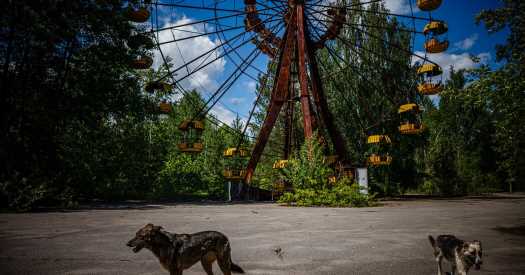After the disaster at the nuclear power plant in Chernobyl, Ukraine, in 1986, local residents were forced to permanently evacuate, leaving behind their homes and, in some cases, their pets. Concerned that these abandoned animals might spread disease or contaminate humans, officials tried to exterminate them.
And yet, a population of dogs somehow endured. They found fellowship with Chernobyl cleanup crews, and the power plant workers who remained in the area sometimes gave them food. (In recent years, adventurous tourists have dispensed handouts, too.)
Today, hundreds of free-ranging dogs live in the area around the site of the disaster, known as the exclusion zone. They roam through the abandoned city of Pripyat and bed down in the highly contaminated Semikhody train station.
Now, scientists have conducted the first deep dive into the animals’ DNA. The dogs of Chernobyl are genetically distinct, different from purebred canines as well as other groups of free-breeding dogs, the scientists reported Friday in Science Advances.
It remains too soon to say whether, or how, the radioactive environment has contributed to the unique genetic profiles of the dogs of Chernobyl, the scientists said. But the study is the first step in an effort to understand not only how long-term radiation exposure has affected the dogs but also what it takes to survive an environmental catastrophe.
“Do they have mutations that they’ve acquired that allow them to live and breed successfully in this region?” said Elaine Ostrander, a dog genomics expert at the National Human Genome Research Institute and a senior author of the study. “What challenges do they face and how have they coped genetically?”
Before the researchers could tackle these questions, however, they had to get the lay of the canine landscape.
“You have this region where there’s different levels of radioactivity, there’s dogs living everywhere,” Dr. Ostrander said. “We had to know who was who and what was what before we could begin our hunt for these critical mutations.”
The project is a collaboration among scientists in the United States, Ukraine and Poland, as well as the Clean Futures Fund, a nonprofit based in the United States that works in Chernobyl. The nonprofit, which was established in 2016, began as an effort to provide health care and support to the power plant employees, who still work in the exclusion zone.
But the organization soon realized that Chernobyl’s canine residents needed help, too. Although the dog population boomed during the summer, it often crashed in the winter, when food became scarce. Rabies was an ongoing concern.
In 2017, the Clean Futures Fund began holding veterinary clinics for the local dogs, providing care, administering vaccines, and spaying and neutering the animals. The researchers piggybacked on these clinics to collect blood samples from 302 dogs living in different locations in and around the exclusion zone.
Nearly half of the dogs lived in the immediate vicinity of the power plant, while the other half lived in Chernobyl City, a lightly occupied residential area about nine miles away. (A small number of samples came from dogs in Slavutych, a city built for evacuated power plant workers, nearly 30 miles away.)
Although there was some overlap between the canine populations, in general, the power plant dogs were genetically distinct from the Chernobyl City dogs, the researchers found. There appeared to be little gene flow between the two groups, suggesting that they rarely interbred. (Physical security barriers around the power plant may have helped keep the dogs apart, the researchers noted.)
“I was completely surprised by the near total differentiation between the two populations, the fact that they’ve existed really in relative isolation for quite some time,” said Timothy Mousseau, a biologist at the University of South Carolina and the other senior author of the study.
The researchers also traced kin relationships, connecting parents and offspring to identify 15 different family groups. Some dog families were large and sprawling, while others were tiny, with more defined geographic territories. Three family groups shared a storage facility for spent nuclear fuel, the scientists found.
“I don’t think anybody has looked at a single, free-breeding dog population genetically at this level of detail before,” said Adam Boyko, a canine geneticist at the Cornell University College of Veterinary Medicine, who was not involved in the research.
The study will be a good starting point for further investigation of the effects of radiation, Dr. Boyko added. “They find where the interesting populations are,” he said, “where the interesting family groups are.”
The power plant dogs and the Chernobyl City dogs had mixed breed ancestry, but both shared stretches of DNA with German shepherds, as well as other Eastern European shepherd breeds. The dogs from Chernobyl City also had variants that are common in boxers and Rottweilers.
These segments of shepherd DNA might yield particularly useful data in future studies, the scientists said. Comparing these sequences from the power plant dogs, the Chernobyl City dogs and purebred shepherds living in nonradioactive environments might help the researchers identify radiation-related changes in the genome.
“This is a unique opportunity,” Dr. Mousseau said, “a unique population of animals.”
Source: Read Full Article
